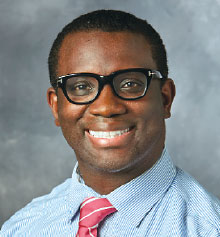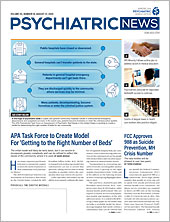People across the country continue to take to the streets to advocate for racial justice, with many physicians also taking up the mantle of anti-racist activism and attempting to bring it into their practices.
For Matthew L. Edwards, M.D., today’s movements do not differ so much from those of the past. “In many ways, I see the current racial justice advocacy efforts as aligned with historical efforts to promote racial justice and health equity,” he said.
Edwards is a fourth-year resident and chief resident in psychiatry at Stanford University School of Medicine. He is also the editor-in-chief of the American Journal of Psychiatry Residents’ Journal and an APA/APAF Public Psychiatry Fellow. His work has focused on the history of medicine and psychiatry, with a growing focus on race, culture, and medicine.
No area of civil discourse, such as health, housing, income, criminal justice, politics, or media, is unrelated to racial inequity and disparity, he explained. “Historically, medicine has been an institution that, at times, has tried to address some of these issues,” he said, “but at other times has been silent or even adversarial.”
The History of Freedom House
Edwards has most recently focused his work on the Black pioneers who started one of the first training programs in emergency medical services (EMS) and set national standards for care. In a paper published in the Journal of the History of Medicine and Allied Sciences, he explored the history of the Freedom House Enterprises Ambulance Service, which trained Black citizens of Pittsburgh in the late 1960s and early 1970s to provide emergency care before taking them to the hospital.
Freedom House emerged during a time when most emergency health care was provided by police officers, firefighters, and morticians, sometimes voluntary and sometimes paid. Such a system had its problems, Edwards explained, including lack of trust between citizens and law enforcement and inadequate care provided by untrained individuals.
But over its years of operation, Freedom House set the standard for EMS care, Edwards said. “This group of unlikely heroes, these 40 or 50 African Americans, mostly men and some women, did really remarkable things,” he said. “They became a bastion of the city and were called upon to care for the sickest people.”
Nonetheless, they faced resistance from city officials and white firefighters in suburban fire departments who saw Freedom House as a threat to their income and professional autonomy. Freedom House was eventually shut down in 1975 after a loss of funds over years, and an ambulance service with predominantly white workers replaced it.
“It was a fateful irony, as an ex-Freedom House paramedic observed, that the role of poor Black neighborhoods in helping establish the field of emergency medicine could be erased so quickly from the national memory,” Edwards wrote.
Freedom House’s story, he told Psychiatric News, is incredibly rich and explores issues that arose at the height of the civil rights movement. “People took activism to the streets, and that activism led to these innovative social programs to help democratize health care in society,” he said. “But at the same time, these programs largely failed because their leaders didn’t account for the systemic injustices and implicit biases within the system.”
When Physicians Advocate, Professional Is Personal
There has always been tension over whether physicians should engage in activism on behalf of their patients, Edwards said. PubMed is filled with papers on the subject. Some claim that physicians should be involved in activism and advocate for racial justice. Others suggest physicians should stick to medicine and not risk alienating some patients through their social activism.
In his research, Edwards has found that, historically, there is a distinction between agency and activism. Agency means acting on behalf of the patient, such as reducing individual barriers to care for patients with sickle cell disease. Activism refers to efforts to advocate for broader, societal goals, and it may intersect with personal experiences. This activism might involve advocating for increased funding and research for sickle cell disease. Historically, agency for patients among physicians has been more widely accepted than activism for social and structural changes, Edwards explained.
The 1960s was a watershed time for social and racial justice activism among physicians, Edwards said. “We know that Black physicians participated in sit-ins, protests, marches, picket lines, and more,” he said. “They were very much part of the on-the-ground efforts. The understanding was that Black physicians faced discrimination both in their general lives and in their profession. In this context, the distinction between activism and agency becomes quite blurred. For many people, the professional is personal.”
At the demonstrations and protests that have taken place since the death of George Floyd, Edwards said he has seen some signs advocating for specific health-related issues, such as funding for sickle cell research and obstetric care for Black women.
“What we see now is a convergence of experiences underscoring that not only is health care a basic human right, but also that racial tolerance and racial justice are also part and parcel of that right,” he said. ■
“Pittsburgh’s Freedom House Ambulance Service: The Origins of Emergency Medical Services and the Politics of Race and Health” is posted
here.

